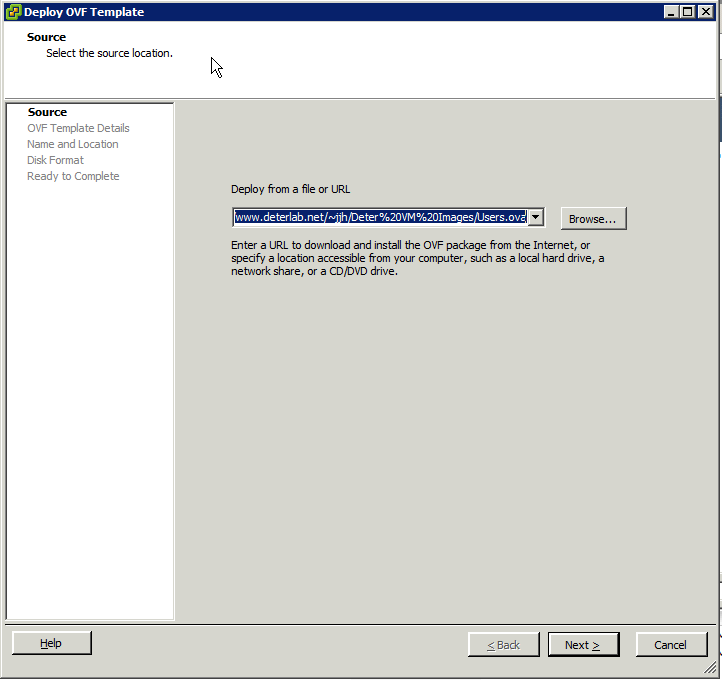| Version 19 (modified by , 12 years ago) (diff) |
|---|
Table of Contents
Virtual Machine Setup Notes
Server Templates
There are three VMWare templates available at http://deterlab.net/~jjh/Deter%20VM%20Images/ for Boss, Users, and Router nodes. These images don't contain the DETER source, but do have all packages required package to build the testbed source.
Templates are easy to deploy on your local ESXi server.
In the 'vSphere Client' Select 'File'->'Deploy OVF Template' and put in the URL for the OVA template you are deploying:
The default root password is 'deterinavm', make sure to change it!
A note about Virtual Machines and CPU core allocation
The boss and users templates come configured to use 4 CPUs. This is problematic on VMWare servers with less than 4 CPUs, since you can only give a VM up to as many cores as the ESXi host has. If you are installing onto an ESXi host that has fewer than 4 CPUs, you will have to edit the number of allocated cores in the VM settings for boss and users before being able to boot them.
General FreeBSD Configuration
You will want to configure your internet facing VM interfaces. The main configuration file for FreeBSD is /etc/rc.conf and the configuration lines for the interfaces are near the top. You might also want to configure /etc/resolv.conf for initial setup (after setup, you will be using the DNS server on Boss).
Configuring FreeBSD is beyond the scope of this documentation, but the FreeBSD Handbook is an excellent reference for most FreeBSD systems administration tasks. Also, FreeBSD features very complete man pages.
Users Image Notes
The users image contains two disk images. One is for the main operating system and the other is for NFS exported filesystems. These are kept separate in order to make it easy for sites to deploy a bigger NFS export filesystem. You may want to replace the second image with a larger image. Here are the steps used to setup the original /big disk (which is 80GB). Make sure to pay attention to the device you are setting up. If you are adding a third disk to replace the existing big, you will probably be dealing with 'da2':
root@users:/root # dmesg | tail da1 at mpt0 bus 0 scbus2 target 1 lun 0 da1: <VMware Virtual disk 1.0> Fixed Direct Access SCSI-2 device da1: 320.000MB/s transfers (160.000MHz DT, offset 127, 16bit) da1: Command Queueing enabled da1: 81920MB (167772160 512 byte sectors: 255H 63S/T 10443C) root@users:/root # gpart create -s gpt /dev/da1 da1 created root@users:/root # gpart add -t freebsd-ufs da1 da1p1 added root@users:/root # tunefs -j enable /dev/da1p1 Using inode 4 in cg 0 for 33554432 byte journal tunefs: soft updates journaling set root@users:/root # vim /etc/fstab root@users:/root # cat /etc/fstab # Device Mountpoint FStype Options Dump Pass# /dev/da0p2 / ufs rw 1 1 /dev/da0p3 none swap sw 0 0 /dev/da1p1 /big ufs rw 1 1 root@users:/root # mount /big root@users:/root # df -h Filesystem Size Used Avail Capacity Mounted on /dev/da0p2 73G 11G 56G 16% / devfs 1.0k 1.0k 0B 100% /dev /dev/da1p1 77G 32M 71G 0% /big root@users:/root # cd /big root@users:/big # mkdir groups proj share users root@users:/big # ls .snap .sujournal groups proj share users root@users:/big #
The users image is also configured with 'tinyproxy' which will allow isolated testbed nodes to fetch packages via HTTP. The configuration is /usr/local/etc/tinyproxy.conf. The proxy should be configured to only listen to requests coming from the control network.
Boss Image Notes
Nothing special to note yet.
Router Image Notes
This image is minimally configured to route between the various networks. It is also configured to route/relay Multicast and DHCP requests between boss and the control network.
Attachments (2)
- Deploy OVA.png (31.7 KB) - added by 12 years ago.
-
Network Mapping.png (32.5 KB) - added by 12 years ago.
Image of the ESXi template deployment network mapping
Download all attachments as: .zip

